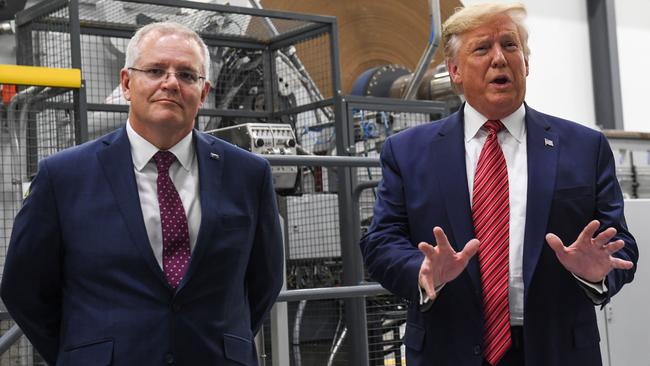Scott Morrison’s chance to bounce back from the bushfires
Scott Morrison will be rewarded for unveiling a bold emissions and energy policy.

The US President, of course, praised the creation of new jobs in his heartland, talked up the environmental advantages and credited it all to his economy-boosting corporate tax cuts.
Talking to the new workers, Trump declared: “Every year, you will recycle discarded paper into 400,000 tonnes of high-quality new paper and more than 300 million boxes — all without cutting down a single tree. Not a single tree comes down.
“Proving that we can protect our environment and grow our economy at the same time.
“This massive new investment is made possible by the historic tax cuts and tax credits that we signed into law.
“We lowered our business tax from the highest anywhere in the developed world to one that is extremely competitive — even really considered pretty low — meaning a lot of companies, like from Australia and other places, are coming over.”
Trying not to look embarrassed at the loss of so much investment from Pratt Industries to the US, the Australian Prime Minister likewise welcomed the creation of jobs. “Jobs is what creates those choices and opportunities. So what we’re celebrating here is jobs,” he said.
During the same US visit Morrison praised Trump’s job creation and the cut in US industry’s carbon emissions through technology, and told the UN Australia intended to take practical steps to lower greenhouse gases and address plastic pollution.
Morrison is preparing to unveil a “road map” next week on how to reduce long-term carbon emissions through technology in an attempt to seek a viable political compromise on climate change that can win the support of most Coalition MPs.
The practical principles he set out at the UN include encouraging private industry to make money out of waste, power generation and carbon capture, limiting government investment to seeding funds, keeping power affordable, maintaining jobs, being technologically agnostic and reducing carbon emissions.
At the same time Morrison will argue that Labor’s net zero carbon emissions target by 2050 is a target without a plan, uncosted and a threat to Australian jobs, while the Coalition is “meeting and beating” its Kyoto and Paris agreement targets for cutting carbon emissions.
There is no doubt Morrison has immediately exploited what he sees as a major mistake by Anthony Albanese in adopting an uncosted promise 30 years hence that did so much damage to the ALP at the last election.
As Energy and Emissions Reduction Minister Angus Taylor said on Friday: “A long-term strategy should be scenario-based, it should be modelled, and it should seek to take advantage of world trends in technology.
“Government investment is important as both a market signal and leader. To be successful from both a portfolio and from a technology perspective we must track how much private-sector and other investment in R&D and early deployment follows our own investment.”
It is also clear the summer of bushfires has significantly raised public awareness and acceptance of the effects of climate change and it is not feasible for the Coalition to go to the next election without a unified energy and climate change policy.
While challenging and fiendishly difficult, it is an opportunity for Morrison to use the public sentiment as a discipline for his colleagues and a chance to reset his agenda in 2020, which stalled because of the public and political impact of the bushfires over summer.
Morrison is also aware that despite a clear shift in acceptance about climate change effects there is still a strong theme of practicality in the Australian psyche and an understanding the immediate cause of the bushfires was the extended drought and insufficient hazard reduction. As well, there is still the public demand for job security and affordable power.
There is also a shift, certainly not as pronounced as on climate change, in the public debate about nuclear energy in Australia, with the latest technology and the attraction of “zero carbon emissions” from nuclear power plants. A parliamentary committee has suggested Australia look at nuclear and there has finally been approval for a nuclear waste facility.
Labor has always had an illogical and contradictory attitude to nuclear power and uranium mining, and the commitment of a “big idea” from Morrison on considering nuclear power would provide an entirely new perspective on the energy and climate change debates.
Indeed, on Friday Morrison took aim at Labor’s 2050 zero emissions target and nuclear policy, declaring: “Labor is saying, ‘well, you can’t get there’ and you can’t use gas because they’re against fossil fuels. You can’t get there and use hydrogen if you do it by anything else other than wind by windmills.
“They’ve got no position on nuclear that will help them get there. They don’t want coal-fired power stations to keep running. So how on Earth is this thing supposed to work? This is why it is just such a mindless commitment by Anthony Albanese,” Morrison said.
As far as other technology answers are concerned Morrison would do well to look at some of the detail of the founding of the Pratt paper plant in Ohio. While Trump and Morrison were shown around the spotless factory and Anthony Pratt credited the US tax cuts there was a crucial detail that no one mentioned: the paper recycling factory was ultimately able to be built in Wapakoneta because it had a cheap source of power.
Not only was the power cheap, it was coming from recycled materials including plastic, which reduced plastic pollution, sequestered carbon, didn’t create difficulties for the grid and wasn’t subsidised.
What’s more, the technology was developed by a firm, Global NRG, now based in Alaska, which had given up being based in Australia and gone to the lower tax environment of the US.
Global NRG is a waste-to-energy company that uses plastics, crop and wood wastes, animal manure, dead and burnt trees, forest floor seed husks, rice and wheat straw, corn cobs, palm shell, sewage sludge and peanut shells to make gas that can provide power, hydrogen and liquid fuels.
The processes can also produce charcoal and biochar. Global NRG has contracted to turn the ghostly skeletal remains of dead gum trees in the mountains of the Monaro region in NSW into biochar and is looking at establishing a waste-to-energy plant in the NSW Riverina that would use chicken manure and rice and wheat straw from local industries to supply cheap power to winemakers in the region who operate on a vast industrial scale.
The remote power generation, which can be linked to the electricity grid by teaming with solar and wind farms, offers the prospect of helping regional centres clear waste, reduce landfill, cut carbon emissions and provide cheaper power.
Global NRG president Mike Bartlett, an Australian, told Inquirer on Friday that in Alaska remote villages that have high electricity costs because of their remoteness and diesel generation costs are being helped by waste to energy.
“We are overcoming this by installing biogas generation, using fish waste to make the biogas,” he said. “While in Australia I have been looking at how we could use hydrogen fuel cells in microgrids to drop the home electricity bill down to 14.5c/kWh and how to build a matrix of hydrogen refuelling points across Australia so that transport could be decarbonised and be more than competitive with fossil-fuelled transport.
“I believe we have the answer based on what we are doing in the US and in Alaska,” he said.
Bartlett also says the waste used to make energy can come from trees killed by bushfires as well as from the undergrowth cleared from the forest floor for hazard reduction.
Morrison’s choices for the combined energy and emissions policy, essential to Australian business and the Coalition’s success, range from nuclear power to chicken shit. The bolder he is, the more likely he is to recover from bushfire backlash and earn further authority when dealing with the unpredictable coronavirus crisis.




In September last year, Scott Morrison joined Donald Trump to attend a presidential rally disguised as the opening of a new Australian-owned recycled paper plant in Ohio that cost $500m, created thousands of new jobs, and would divert thousands of tonnes of waste from landfill and reduce carbon emissions.